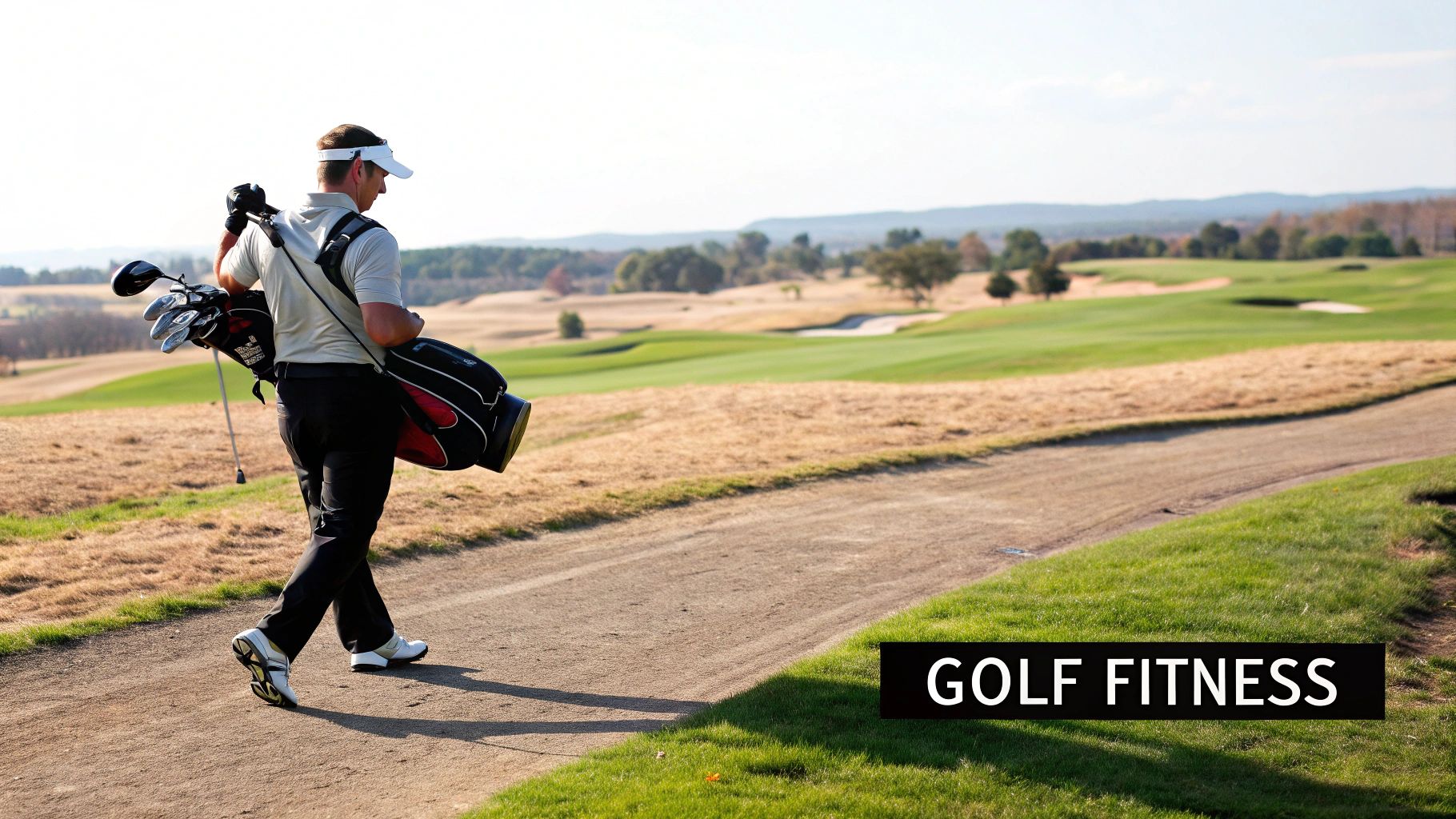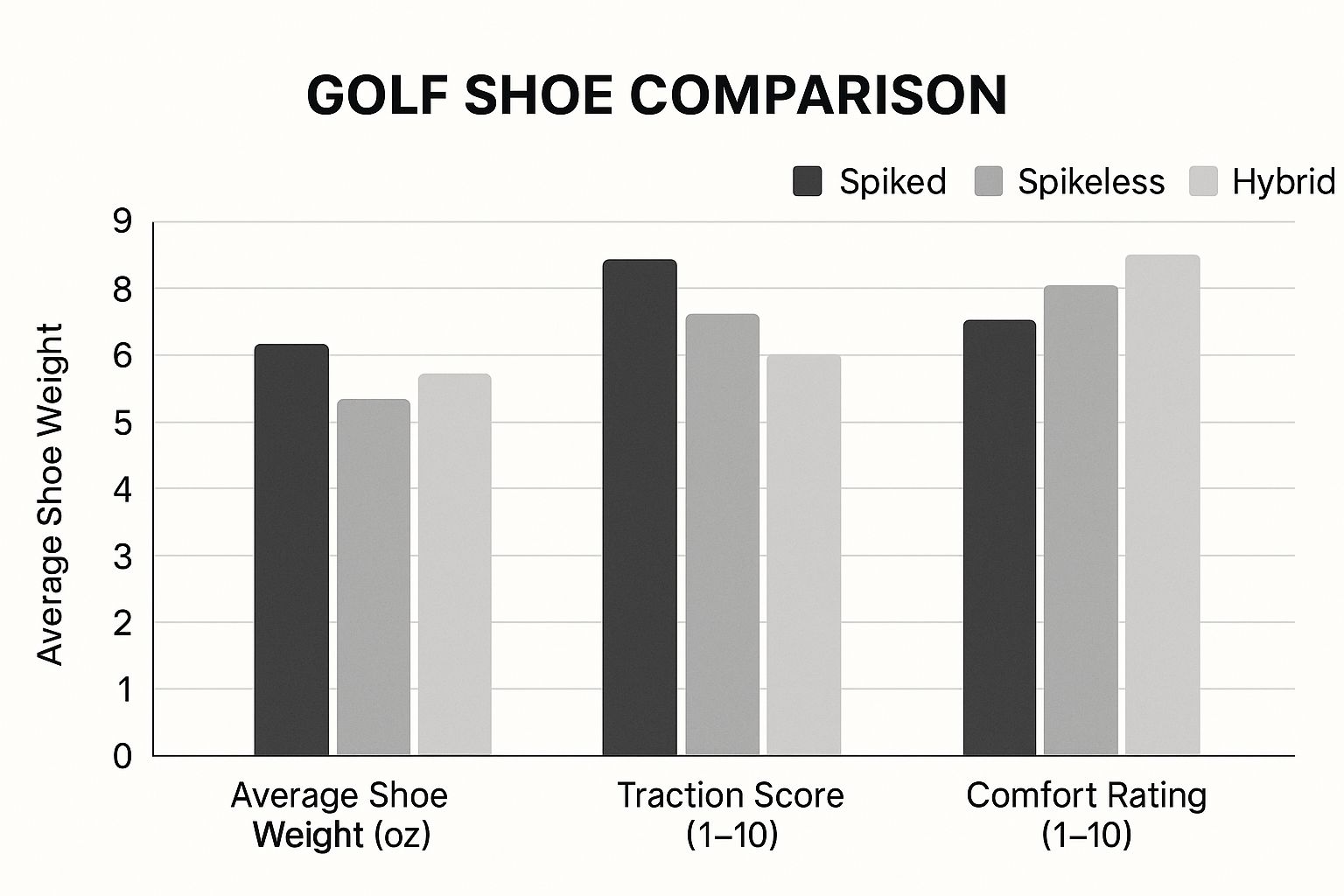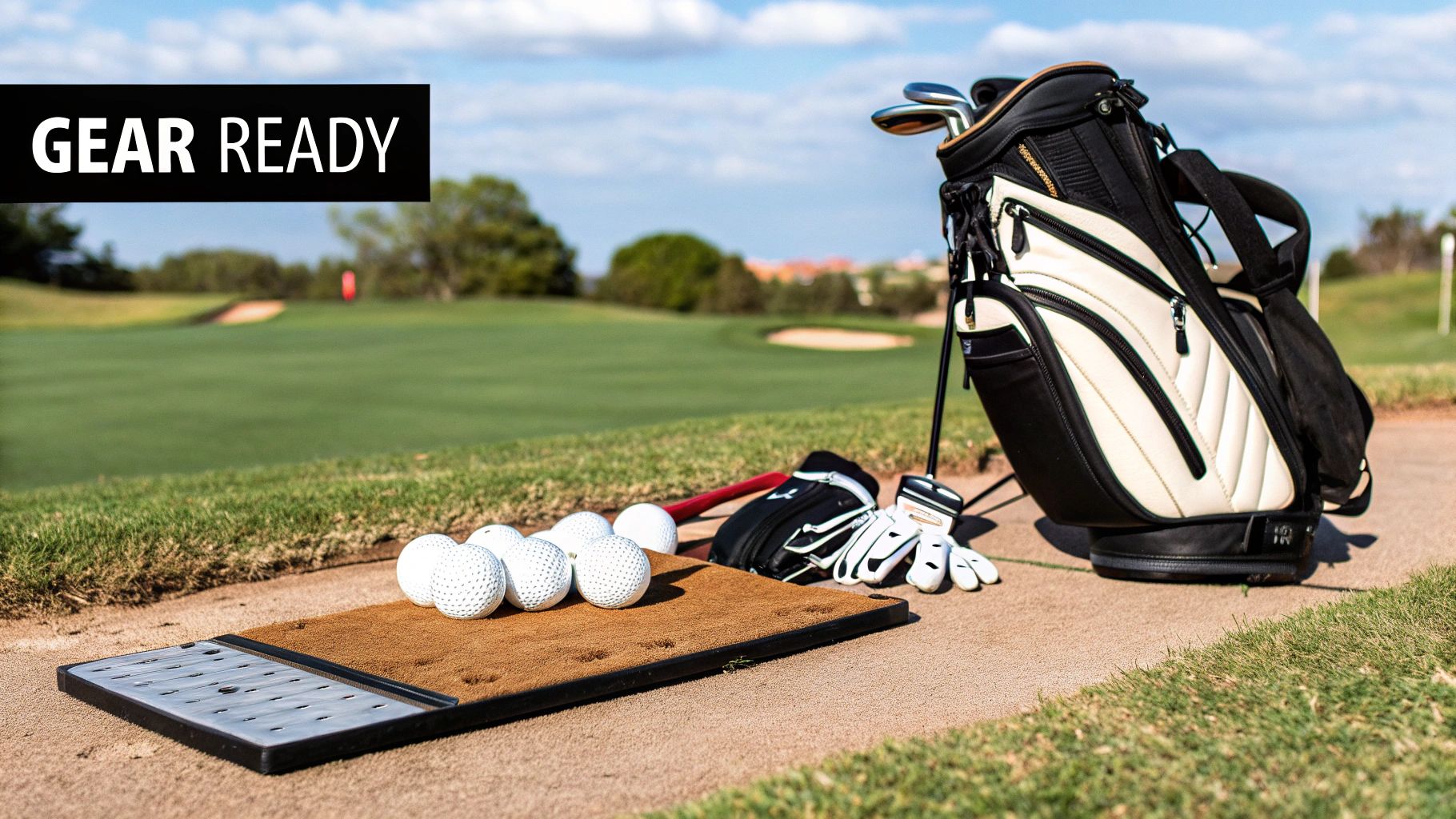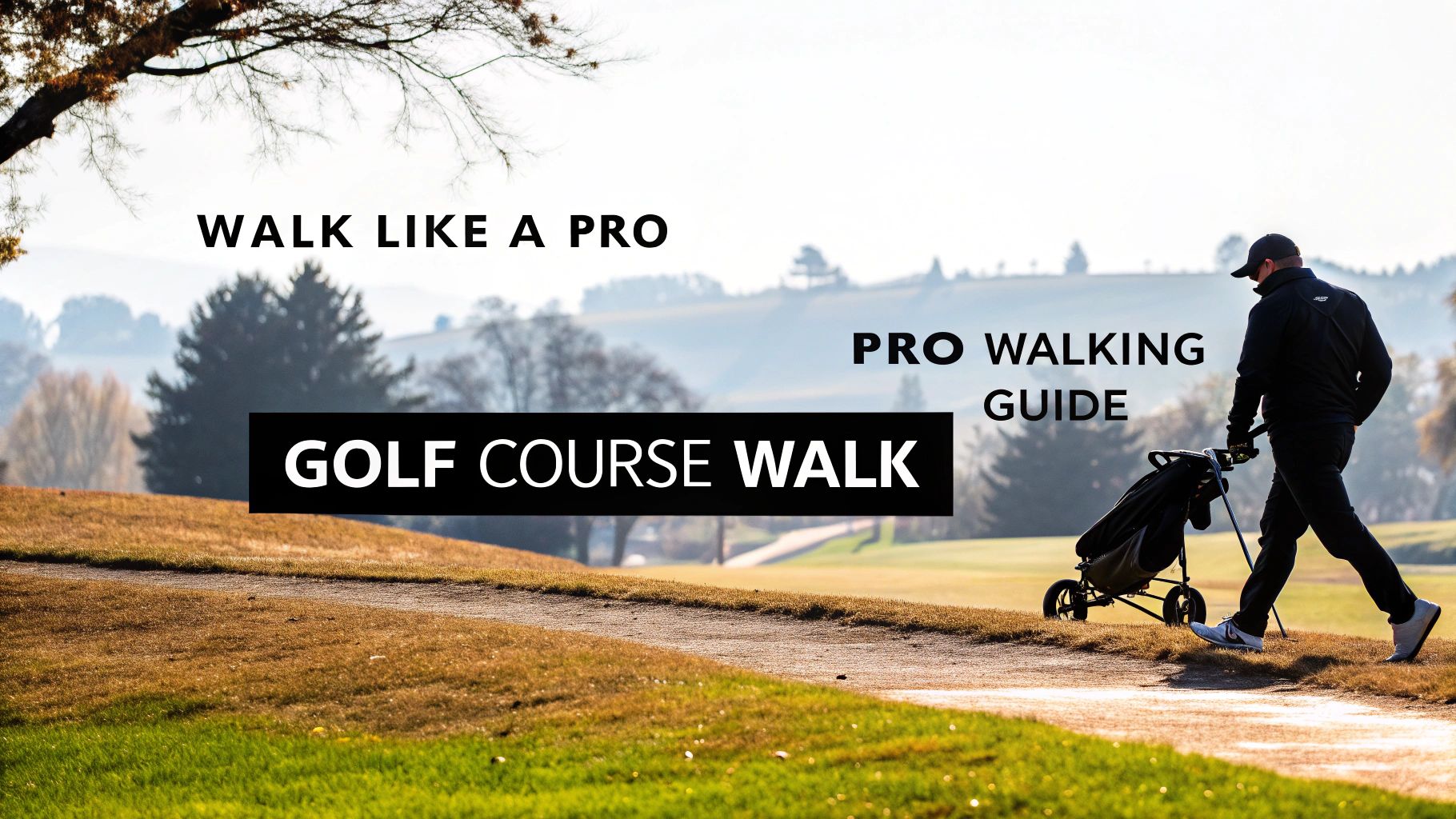Picture this: just you, the course, and the satisfying crunch of your spikes on the fairway. No humming engine, no bumpy cart path—just golf, the way it was originally meant to be played. When you choose to walk a golf course, you’re not just getting some extra steps in. You're plugging directly into the game, turning every round into a richer, more authentic experience.
Rediscover Golf the Way It Was Meant to Be Played

For years, the golf cart has been a staple of the American golf scene. It’s convenient, sure, but it also builds a wall between you and the course itself. Riding in a cart turns the journey between shots into a passive commute, letting you glide right over the subtle details that could be key to your next shot.
When you decide to walk, you flip that script. That commute becomes an active part of your strategy. This isn't just about getting back to the roots of the game for nostalgia's sake; it’s a smart, tactical advantage that more and more players are catching on to.
A Deeper Connection to the Game
Walking immerses you in your surroundings in a way a cart just can't. You can feel the gentle slopes of the fairway under your feet, notice which way the grass is growing, and see the break of the green from a ground-level view. It’s the difference between watching a nature documentary on TV and actually being on the safari.
This deeper connection almost always translates to better play. You get more time to think through your next shot, feel the wind, and visualize the perfect ball flight. The natural rhythm of walking helps you stay sharp and engaged from the first tee to the 18th green.
"Walking allows you to better read the terrain, assess the wind, and make changes to your approach accordingly. In addition, walking can help you get a better feel for the course, which is important for seasoned golfers."
A Growing Movement
This shift back to walking isn't just a hunch; it's a real trend. The golf boom that followed the pandemic has seen a huge jump in players ditching the cart for their own two feet. This movement has never been stronger in America, thanks in part to awesome gear like lightweight bags and advanced push carts that make walking a breeze for golfers of any age or fitness level.
Still, many courses are built around cart culture or have policies that favor riding. If you're ready to join the movement, you can discover more about the state of walking golf in America and find courses that welcome walkers.
By trading the cart path for the fairway, you’re choosing more than just a different way to get around. You’re opting for a more immersive, strategic, and ultimately more rewarding round of golf. It’s about swapping the rush of the engine for the thoughtful pace of a walk, letting you see, feel, and play the game as it was always meant to be.
The Real Health Benefits of Walking the Course
Swapping the golf cart for your own two feet does a lot more than just change your view of the course—it turns your favorite hobby into a surprisingly effective workout. A lot of players write off walking the course as just a leisurely stroll, but don't be fooled. An 18-hole round on foot is a genuine, moderate-intensity workout.
It’s not just about hitting your step goal, either. The simple act of walking, often over hills and varied terrain, gets your heart rate up, builds stamina, and works muscles you might not expect. It's an activity that directly boosts your cardiovascular health and can be a serious part of any weight management plan.
From Leisurely Stroll to Legitimate Workout
The numbers behind walking a golf course tell a compelling story. An 18-hole round is much more than the distance printed on the scorecard. On average, golfers who walk cover about 6 miles per round, which works out to roughly 12,800 steps. That’s a whole lot more than the official yardage, thanks to all the walking between holes, searching for that errant drive, and just navigating the natural layout of the course.
All that activity adds up to a pretty significant calorie burn. Depending on your weight and the difficulty of the course, you can expect to burn anywhere from 800 to 1,500 calories during an 18-hole walk. That’s a serious number, putting it on par with other moderate exercises like a brisk walk or a steady bike ride.
To give you a clearer picture, let's break down the differences between walking and riding.
Walking vs Riding a Golf Cart Comparison
This table really puts into perspective the stark contrast in physical exertion and overall experience between walking and taking a cart for 18 holes.
| Metric | Walking the Course | Riding a Cart |
|---|---|---|
| Average Distance Covered | ~6 miles | ~1 mile |
| Approximate Steps Taken | ~12,800 steps | ~3,000 steps |
| Estimated Calories Burned | 800 - 1,500 | 400 - 800 |
| Type of Exercise | Moderate-intensity | Low-intensity |
| Cardiovascular Impact | Sustained heart rate | Minimal increase |
| Game Engagement | Fully immersive | Disconnected, stop-start |
As you can see, the decision to walk fundamentally changes the nature of your round from a passive activity to an active one.
By choosing to walk, you are making a conscious investment in your long-term health. The sustained, low-impact nature of the exercise is excellent for joint health, and the fresh air and sunshine provide mental health benefits that are just as important.
More Than Just Burning Calories
The perks go way beyond just the calorie count. When you consistently walk the course, you start to see a range of health benefits that build on each other over time. Your weekly round can easily become a cornerstone of your fitness routine.
Here are a few of the key improvements you can expect:
- Improved Cardiovascular Health: All that walking strengthens your heart, improves blood flow, and can help lower your blood pressure and reduce the risk of heart disease. It's a win-win.
- Increased Endurance and Stamina: Regularly tackling 18 holes on foot builds your physical resilience. You'll find that everyday activities feel easier and your overall energy levels get a nice boost.
- Stronger Bones and Muscles: Walking is a weight-bearing exercise, which is fantastic for increasing bone density. It also strengthens your legs, core, and back—and a stronger core can even lead to a more stable and powerful golf swing.
You can take a deeper dive into the 7 unmissable benefits of walking the golf course in 2025 to see just how much it can impact everything from your score to your overall well-being.
The Right Gear Supports Your Health
If you're going to embrace the health benefits of walking, you need the right gear—especially when it comes to your feet. A bad pair of shoes can turn an enjoyable walk into a painful ordeal, leading to blisters, fatigue, and cutting your round short.

This image makes it clear: you don't have to choose between comfort and performance. Some of the most comfortable shoes out there also provide excellent traction, which is absolutely essential for staying stable and preventing injuries on uneven ground. Making the simple choice to walk the course is a profound step toward a healthier, more active life.
Choosing the Right Gear for Your Walk

Having a great day walking the course starts long before you ever step onto the first tee. It really begins with your gear. Picking the right equipment is a lot like choosing the right boots for a long hike—it can be the difference between a miserable slog and a fantastic journey. The biggest decision you'll make is how to get your clubs around, as it directly impacts your energy and enjoyment.
You've basically got three ways to manage your bag on foot: the old-fashioned carry, using a manual push cart, or going high-tech with an electric caddie. Each one has its own trade-offs when it comes to physical effort, cost, and just plain convenience on the course. Let's break them down so you can find what works for you.
The Classic Carry: The Pros and Cons
Carrying your own bag is golf in its purest form. You get total freedom, letting you walk the most direct line to your ball without ever having to steer a cart around a bunker or a tee box. This method is perfect for the minimalist who loves the traditional feel of the game and wants a solid workout.
But that freedom comes at a price. A full golf bag can easily weigh 20 to 30 pounds, and hauling that around for four or five hours takes a toll. The constant strain on your back and shoulders can lead to serious fatigue, which almost always shows up in a tired, sloppy swing on the back nine.
- Pros: Total freedom of movement, no cart to buy, and the best physical workout.
- Cons: High physical strain, can lead to fatigue-induced swing flaws, and pretty much requires an ultralight bag.
The Push Cart: A Balanced Approach
For most golfers, the push cart is the sweet spot. It gets the weight off your back, letting you enjoy all the health benefits of walking without the physical punishment. Modern push carts are brilliantly designed—they're lightweight, fold up easily, and come loaded with handy features like storage consoles, drink holders, and umbrella mounts.
Pushing a cart is way less taxing than carrying, which means you save that precious energy for your shots. Sure, you have to navigate it around the course, but that’s a small price to pay for the huge reduction in physical load. It’s the go-to solution for the vast majority of players who want to walk the course regularly.
A well-designed push cart makes walking accessible to almost everyone. It balances the physical benefits of walking with the practical need to conserve energy, ensuring you finish the 18th hole feeling as strong as you did on the first tee.
To find the perfect model, you can check out this detailed guide on how to choose a golf push cart and see what features really matter.
The Electric Caddie: The Ultimate Walking Upgrade
What if you could get all the perks of walking without any of the pushing? That’s where an electric caddie enters the picture. These motorized carts do all the work, cruising right alongside you with just the touch of a button. This option is an absolute game-changer for players who love to walk but struggle with pushing, especially on hilly courses.
Electric caddies come in two main flavors: fully integrated electric trolleys or add-on motorized wheels. While the all-in-one trolleys can be pricey and bulky, clever accessories like the Caddie Wheel give you a more flexible and affordable path. This kind of device simply attaches to your existing push cart, instantly turning it into a remote-controlled caddie.
This technology lets you walk the course completely unburdened, saving 100% of your energy for what matters—your swing. It's the ultimate way to experience the walk, combining health benefits and strategic advantages with effortless convenience.
| Method | Physical Effort | Initial Cost | On-Course Convenience | Best For |
|---|---|---|---|---|
| Carrying | High | Low | High | Purists and golfers in top physical condition. |
| Push Cart | Medium | Medium | Medium | The majority of regular walking golfers. |
| Electric Caddie | Very Low | High | Highest | Golfers on hilly courses or those wanting zero physical strain. |
Essential Gear Beyond the Bag
Besides how you move your clubs, a few other pieces of gear are non-negotiable for a comfortable walk.
- Properly Fitted Golf Shoes: Your feet are your foundation. Don't skimp here. Invest in a pair of high-quality, comfortable, and waterproof golf shoes. Look for models designed specifically for walkers; they usually have better cushioning and support.
- A Lightweight Golf Bag: Whether you carry or use a cart, a lighter bag just makes life easier. Go through it and ditch anything you don't truly need. A stand bag is almost always lighter than a cart bag.
- Hydration System: Staying hydrated is crucial for keeping your energy and focus up. Use a water bottle that fits your bag or cart's holder, and make sure you refill it every chance you get on the course.
By putting a little thought into your gear, you set yourself up for a successful and much more enjoyable round every single time you walk.
Maintaining Pace and Proper Course Etiquette
One of the biggest anxieties for golfers new to walking is the fear of holding everyone up. There's a common myth that walking is automatically slower than riding, but that’s rarely the case. In fact, a prepared and efficient walker can often set the pace for the entire group.
It all comes down to understanding the natural flow of the game and practicing smart etiquette on the course. The secret isn't about walking faster; it's about walking smarter. This means you have to ditch the "your turn, my turn" mindset that cart golf so often creates. Instead, you adopt a fluid, continuous approach to moving around the course, making sure you're always ready to play when it's your turn.
The Art of Ready Golf on Foot
"Ready golf" is that unwritten rule we all know: the first person ready to hit, hits. When you're walking, this concept is your absolute best friend for keeping a great pace. It’s a proactive way to play that keeps the whole group moving smoothly and without any awkward pauses.
Here’s how you can put it into practice:
- Move While Others Hit: The moment your playing partner hits their shot, start walking toward your own ball. Don't wait around. This simple habit alone can shave a surprising amount of time off your round.
- Plan Your Next Shot: Use your walk to your advantage. As you approach your ball, start thinking about your next move. What's the yardage? What's the wind doing? Have a club in mind before you even get there.
- Streamline Your Routine: A consistent pre-shot routine is fantastic, but it shouldn't be a five-minute production. Get your practice swings in while others are preparing, so when it's your turn, you can just step up, aim, and fire.
By embracing these simple strategies, you eliminate all that dead time and keep a natural rhythm going. For a deeper look into this, our guide on golf pace of play guidelines for a faster round offers even more helpful tips.
Push Cart Etiquette and Positioning
If you're using a push cart, knowing where to park it is a massive part of course etiquette. Your goal is to keep it out of everyone's line of play and positioned for a quick exit to the next hole. Messing this up is one of the most common ways walkers accidentally slow things down.
Never leave your cart in front of a green or in a place that forces other players to walk around you. The best practice is to always leave your cart on the side of the green closest to the next tee box.
This small detail makes a huge difference. When you finish putting out, your cart is already on the path to your next shot. You can just grab it and go without backtracking or crossing in front of another player who's trying to line up their putt.
The same logic applies at the tee box. Find a spot to park your cart that is out of the way but allows you to easily grab your driver and head to the tee. Avoid parking it directly behind the tee markers where you might distract the person hitting.
Here are the key spots to focus on for proper cart placement:
- Around the Green: Always identify the path to the next tee and park your cart on that side of the green. Keep it off the fringe and well away from any bunkers.
- On the Tee Box: Find a level spot on the cart path or in the rough next to the teeing area. Make sure it’s not in anyone’s line of sight while they're swinging.
- On the Fairway: When you walk up to your ball for an approach shot, leave your cart a few paces away and on a direct line toward the green. This keeps you from having to walk back and forth.
Mastering these simple etiquette rules gives you the confidence to walk any course, knowing you're a considerate player who respects the game and the people you share it with.
How to Prepare for Your First Walk

Making the leap from riding in a cart to walking the course is hands-down one of the best things you can do for your game and your health. But to make sure that first walk is invigorating instead of exhausting, a little prep work is key. Think of it less like a massive undertaking and more like a few smart, simple adjustments.
The goal isn't to tackle a hilly, 18-hole championship course right out of the gate. You need to ease into it. A great way to start is by just walking nine holes. This trial run lets you get a real feel for the physical demand, figure out how to manage your gear, and learn to keep pace without the pressure of a full round.
Building Your Endurance and Confidence
Walking a golf course requires a different kind of stamina than you might be used to. You're on your feet for hours, covering miles of ground that isn't always flat. The only way to build up to it is by starting small and staying consistent.
Even if you’re in great shape, the specific demands of walking a course can be a surprise. If that first nine-hole walk feels good, do it a few more times before you even think about 18. This gradual approach is perfect for building physical endurance and, just as importantly, the mental confidence you need to feel like you belong out there.
This method works for just about everyone, even golfers with physical limitations. For example, some fascinating research on golfers with knee osteoarthritis found that walking the course delivered major cardiovascular benefits without aggravating their condition. When walking, these players spent over 60% of their round in a moderate-intensity heart rate zone—compared to only 30% when riding. It's solid proof that walking is a safe and incredibly effective exercise for a huge range of players. You can read the full study on golf's health benefits for all the details.
Planning Your First Full Walk
Once you feel ready to take on a full 18, a bit of planning will make the entire experience much smoother. Remember, not all courses or tee times are walker-friendly.
- Check the Course Policy: Before anything else, call the pro shop and ask about their walking policy. Some courses have restrictions or designate certain times for walkers to keep the pace of play moving.
- Book a Smart Tee Time: Try to snag a tee time when the course is less crowded, like mid-afternoon on a weekday. This gives you a little breathing room and reduces the pressure of having a speedy group right behind you.
- Choose the Right Course: For your first few full walks, do yourself a favor and pick a relatively flat course. A flatter layout is a much kinder introduction than a course with dramatic hills that will zap your energy by the back nine.
What to Pack and What to Leave Behind
When you're walking, your gear list is all about efficiency. The name of the game is carrying only what you absolutely need. This isn't the time to pack for every possible scenario.
The golden rule for a first-time walker is simple: if you have to ask yourself whether you’ll need it, you probably don’t. Pack light, and your back and shoulders will thank you on the 16th hole.
Here’s a quick checklist to get you started:
- Water and Snacks: This is non-negotiable. Pack a reusable water bottle and some light, energy-boosting snacks like nuts or a granola bar. Staying hydrated and fueled is critical.
- Essential Clubs Only: Be honest with yourself. Do you really use all 14 clubs? Leaving a couple of those specialty wedges or long irons at home can shed a surprising amount of weight.
- Fewer Golf Balls: Bring one sleeve of balls and maybe a couple of extras for peace of mind. Lugging around two dozen "just in case" balls is dead weight.
- Weather-Appropriate Gear: Check the forecast. A lightweight, waterproof jacket and a small towel are smart additions that won't weigh you down.
By preparing your body, your schedule, and your bag, you’re setting yourself up for an awesome first walk. The focus should be on enjoying the journey, one step at a time.
Common Questions About Walking a Golf Course
Even with all the clear benefits, the thought of walking a full round of golf can still feel a bit daunting. It’s completely normal to have questions about pace of play, course rules, or just the physical side of things.
Let's clear the air and tackle some of the most common questions head-on. My goal is to get you feeling confident and ready to hit the fairway on your own two feet.
Is Walking Significantly Slower Than Riding?
This is probably the biggest myth out there, and the answer is almost always a resounding no. A walker who knows how to play "ready golf" can easily keep pace with—and often even outplay—a group in a cart.
Think about it for a second. A golf cart has to stick to a designated path, which is rarely a straight line to anyone's ball. As a walker, you head directly to your own ball while your partners are hitting. That efficiency often beats the "speed" of a cart, especially on days when the dreaded "cart path only" rule is in effect. You can get to your ball, figure out your yardage, and be ready to swing well before your friends in the cart even get there.
How Do I Know if a Course Allows Walkers?
The easiest and most reliable way is also the simplest: just call the pro shop. A quick phone call before you even think about booking a tee time will give you a direct, no-nonsense answer. While many courses are more than happy to have walkers, some might have specific policies or designated tee times to keep the flow of play smooth.
You might find a course's walking policy on its website, but that information isn't always current. Don't leave it up to chance. A two-minute call can save you the headache of showing up to a course that requires carts for your tee time.
A common misconception is that all private or high-end courses forbid walking. In reality, many of the world's most prestigious courses are designed for walking, viewing it as the traditional and proper way to experience the game.
Do I Need a Special Golf Bag to Walk?
Technically, you can walk with any golf bag, but trust me, the right one makes all the difference in the world. If you're planning to carry your clubs on your back, a lightweight stand bag or a minimalist carry bag is your best friend. Every single ounce matters when you're covering 6 miles on foot.
If you’re using a push cart, most modern cart bags and stand bags will fit just fine. The most important thing is simply to cut down on unnecessary weight. Before you head out, do a quick audit of your bag—get rid of the extra sleeves of balls, the rain gear on a sunny day, and anything else you don't truly need for that round.
What Is the Best Way to Start if I Am New?
The key is to start small and build up. Your first walking round shouldn't be an 18-hole death march on a hilly championship course. Ease into it.
- Begin with nine holes: This is a great way to see how your body feels and get into the rhythm of walking the course without overdoing it.
- Choose a flatter course: Save the challenging, hilly layouts for when you've built up a bit of stamina. No need to make it harder than it has to be at first.
- Focus on the experience: For your first few walks, don't even worry about your score. Just enjoy the fresh air, the exercise, and the unique perspective you get from seeing the course on foot.
Walking a golf course connects you to the game in a special way, but pushing a heavy cart, especially on hilly terrain, can take away from the enjoyment. The Caddie Wheel solves this problem by turning your favorite push cart into a powerful, remote-controlled electric caddie. You get all the health and strategic benefits of walking, but with none of the fatigue. Save your energy for the perfect swing and enjoy every step of your round by visiting https://caddiewheel.com to see how it can upgrade your game.


Share:
7 Best Walking Electric Golf Carts for Your 2025 Rounds
Your Guide to a Golf Cart Battery Upgrade